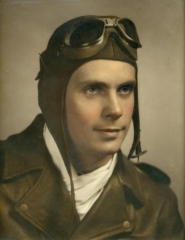William Dunn

William Dunn Sr
WILLIAM
DUNN
SR
SOLDIER DETAILS
BIOGRAPHY
William "Bill" Dunn Sr. was attending college at Rockhurst, when Pearl Harbor happened. Two months later his father, JE Dunn, a small construction contractor won a bid to construct a Quarter Master depot in Kansas City. Bill worked on the job for $1 a day as a water boy. His father completed the contracted work with 20-hour days, 10 hours on, 10 off, his crews completed the task three days ahead of schedule. Mr. Dunn was shocked, to discover that the company made $200,000 profit. But he wouldn’t accept it. “He got in touch with government leaders and said he had no desire to make money on the war,. The government issued a change order, and JE Dunn ended up performing the work at cost.
By then, Bill had joined the Naval reserves and was a Junior at Noter Dame. At Christmas, Bill visited his older brother, who was in the Navy, stationed at Pensacola. Bill was interested in joining and took a test and scored well and could go to the Air Corp but at the time they had plenty of recruits. So he went back and finished his Junior year at Notre Dame. That is when he got a call from a Math instructor associated with the Air Corp. He asked Bill to teach a class on Celestia navigation, which he had no knowlege of and was trained as he was teaching it to recruits. Finally, around ten months after passing the test to become a pilot, Bill was called up for training, going to Memphis, TN before transferring to Pensacola. Bill was told the Military still had an abundance of pilots, as not as many were being lost in the war as expected. Half of those in the program were asked to go home or become a seaman. Bill, however, got to stay and was trained to fly a single engine, light weight plane that was called a scout plane. While the "traditional" role of scout planes was to spot enemy fleets, during World War II scout planes were essential for battleships and other surface warships during bombardment of land targets, as it was difficult to see an enemy position, even with binoculars These plans were catapulted off of air craft carriers. A catapult that ran across the beam of the ship down in the hangar bay, with big doors on each side. This way, a scout plane or two could be launched in a pinch when the top deck was fouled. These catapults were shorter and offered a quicker stroke than the upper deck systems, and the aircraft did not have the benefit of the wind blowing over deck for help to become airborne either. Even a cross wind was more usual than not. As such, it was a wild ride for crews tasked with getting airborne from the hangar deck. The scout plane catapulted was like being shot out of a cannon. Bill returned home and began working with his fathers' construction company, and eventually became the CEO. JE Dunn construction is a successful organization which is based in Kansas City. Courtesy of c-span.org/person/billdunnsr and wikipedia.
 Eisenhower Foundation
Eisenhower Foundation
